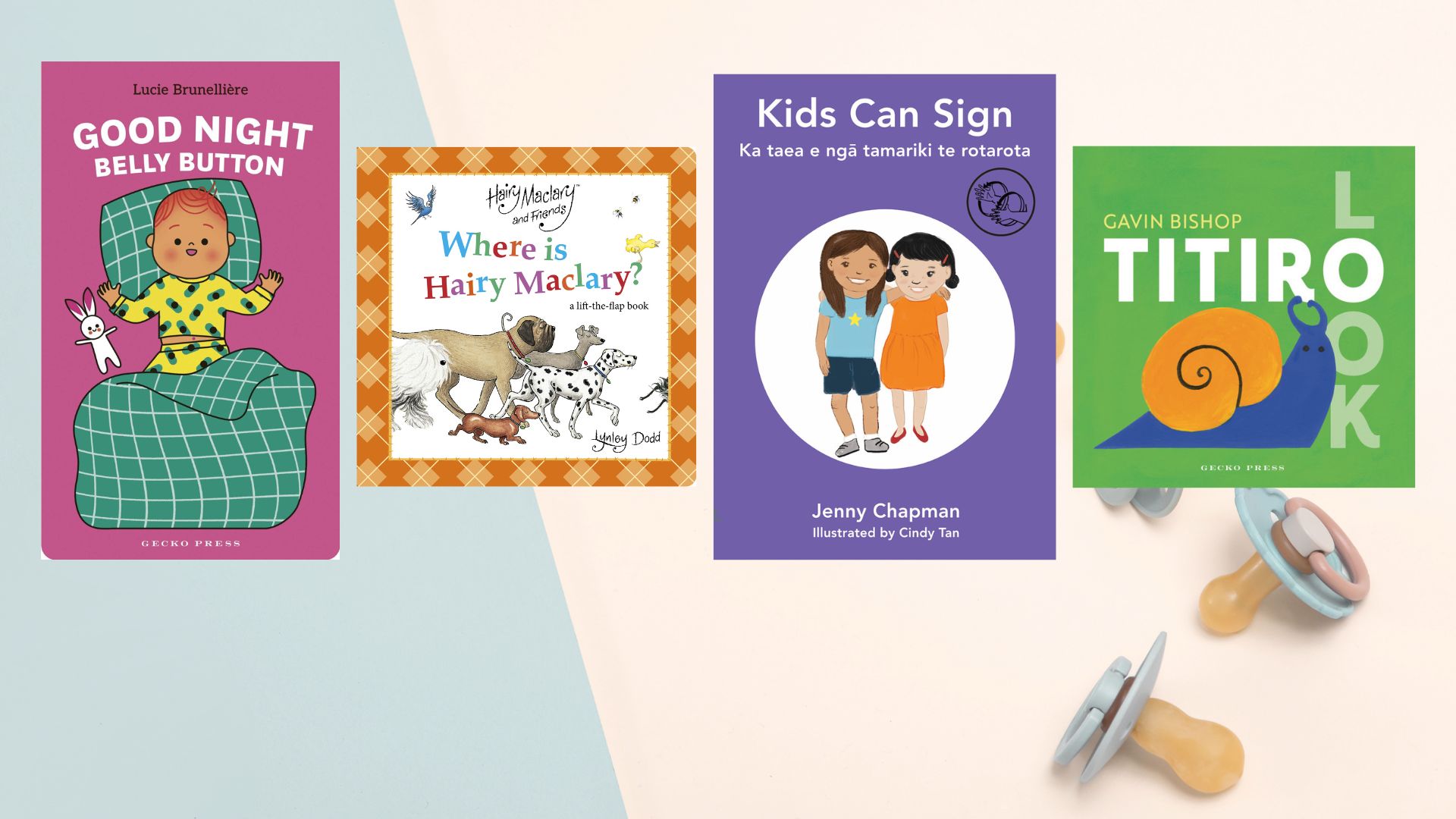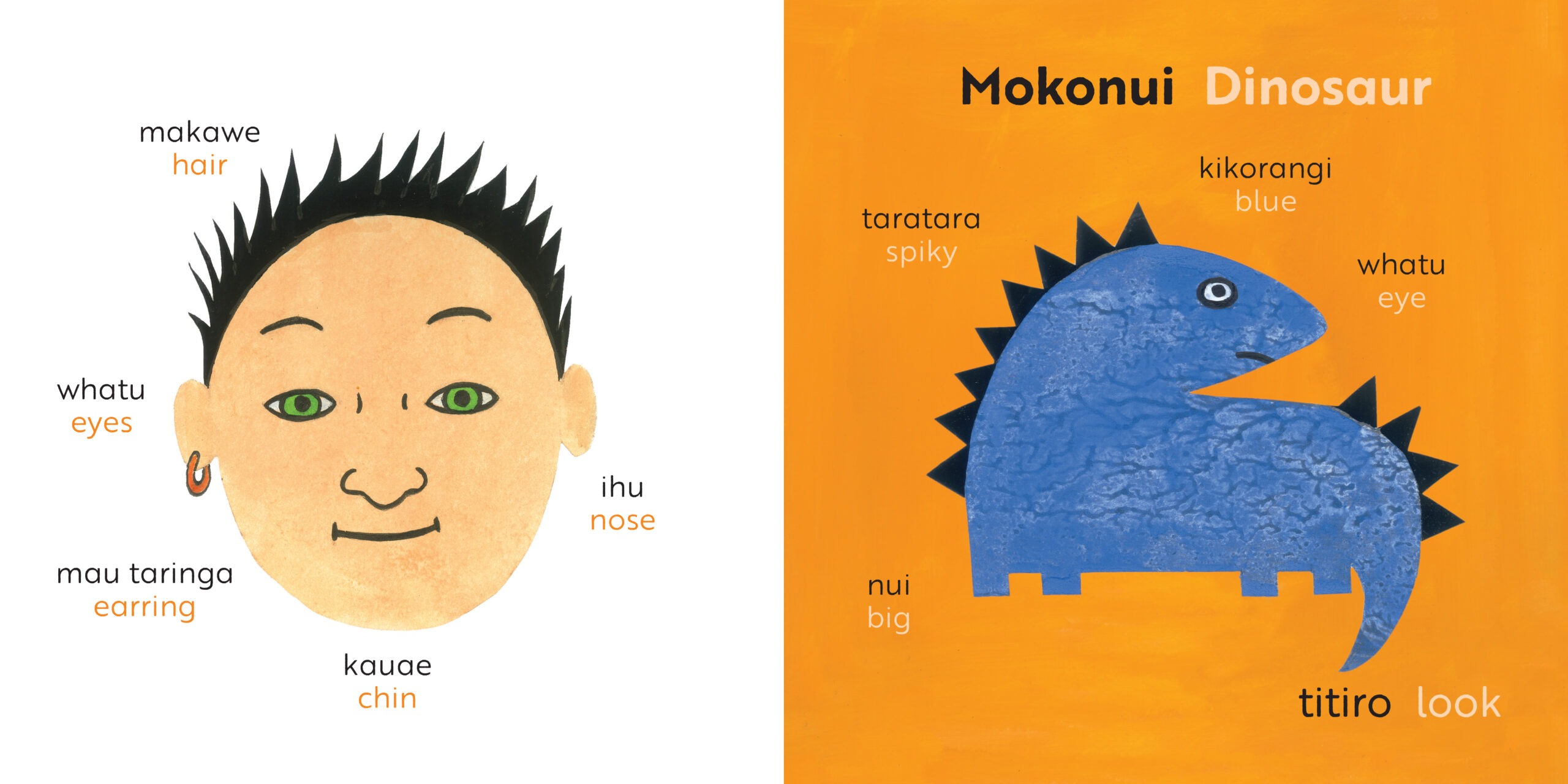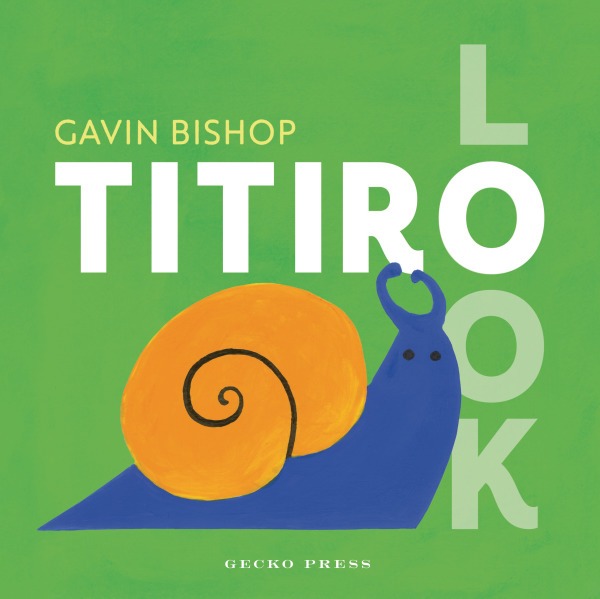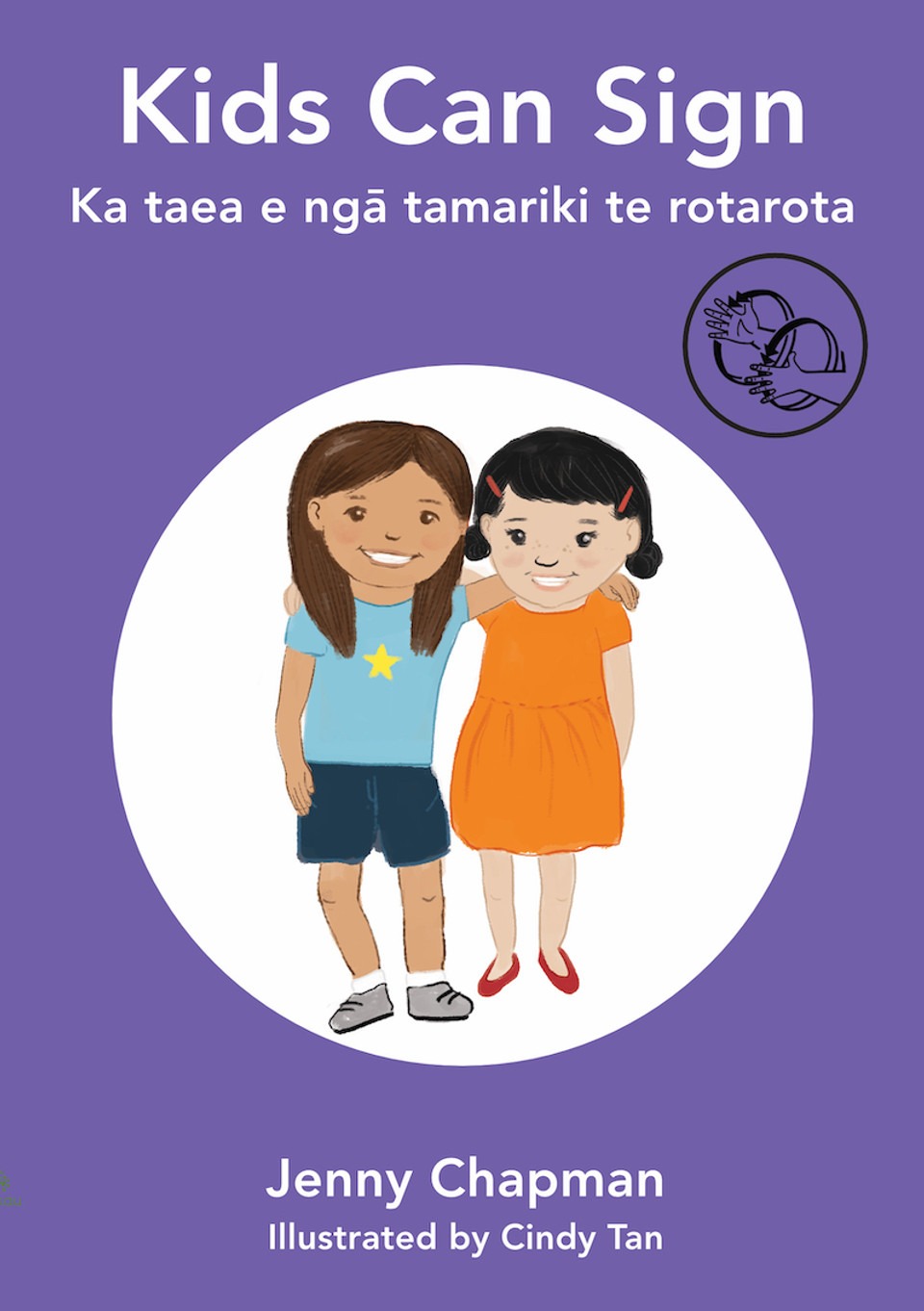Nida Fiazi reviews four board books, with advice from her son.

Good Night Belly Button by Lucie Brunellière
Gecko Press has slowly been taking over my baby’s library and for good reason. Good Night Belly Button by Lucie Brunellière is one of their many translated titles that came out last year (this one being French to English). The concept is simple but effective: wish baby goodnight and tuck them into bed with every turn of the page.
There are only four illustrations in the entire book (including the front and back covers)—five if you count the green check blanket-pages (each one is longer than the last, covering the baby from their ‘little feet’ all the way to their ‘little chin’). The bold colour palette and crisp line art work really well together and immediately grab your attention—it’s easy to tell that Brunellière has a background in graphic art.
The vertical reading experience was a tad awkward at first, but I quickly figured out that holding the book at a 90 degree angle was the way to go. It’s a bit too long (physically) otherwise and this allowed me to have better control of the pages, regardless of how long or short they were. Speaking of pages, these have a matte finish and despite being pretty solid in their construction, will show obvious signs of love sooner than a traditional glossy lamination might. My son has already gnawed at one corner and the edges of the covers are starting to peel.

We initially read it to our little one in English but made a conscious decision to switch to our own language (Hazaragi) once we realised how easy it was to translate on the fly. I like to use it to teach body parts and object permanence at this stage but as my son gets older it will be the perfect addition to his bedtime routine.
Good Night Belly Button is a short and sweet tale that will grow with your little ones. That is, until they start wanting to dress themselves. But don’t fret, Lucie’s got you and your mini covered (literally) with its companion book titled Get Dressed Belly Button.

Good Night Belly Button
Lucie Brunellière
Gecko Press
$21.99
Buy now
Where is Hairy Maclary? A Lift-the-Flap Book by Lynley Dodd
My transition from child refugee to kiwi kid was aided massively by books—particularly classics from household names such as Margaret Mahy and Lynley Dodd—so you can imagine how full circle it felt to introduce my son (next gen kiwi kid) to the wonderful world of Hairy Maclary.
Published last year, Where is Hairy Maclary? is the most recent addition to the growing lift-the-flap collection of books featuring our beloved pup and his gang. The story takes you through almost all the animal characters (canine, feline as well as a certain special duck) uncovering all their hiding spots, page by page, until Hairy is found.
… the difference between my son yeeting a book over his shoulder and actually finishing the story
Board books are a staple in our home—we’ve had several paper page casualties so we’re steering clear of those until gentle hands are established—and the lift-the-flap kind are definitely one of the most reached for. They’re great for teeny tiny tots on so many fronts: providing multisensorial reading experiences (see, hear and feel beyond just pointing to things on the page), teaching cause and effect (lifting the flaps reveal new information), developing fine motor skills and hand-eye-coordination (mastering those finicky flaps means they’re one step closer to learning how to hold a pencil), and also including/involving little ones in the reading experience by encouraging them to interact with the book. That last point has meant the difference between my son yeeting a book over his shoulder and actually finishing the story—those extra few seconds of attention are not to be undermined!
At a glance, Where is Hairy Maclary? appears very similar to another lift-the-flap book in the series: Hairy Maclary, Hide and Seek, which came out more than a decade ago. However, upon closer inspection it’s easy to spot a few clear differences that make this one stand out against its predecessor such as Dodd’s riveting rhythm and roll-off-your tongue rhymes, the vivid and colourful borders on each page, the addition of visual clues in the illustrations and the fact that each member of the gang (once revealed) leads the way to the next, keeping the momentum of the tale going.
Dodd has delighted generations of readers and it’s safe to say she won’t be stopping anytime soon. Where is Hairy Maclary? is sure to be loved by any budding bookworm that happens upon it.

Where is Hairy Maclary: A Lift-the-Flap Book
Lynley Dodd
Puffin
$19.99
Buy now
Titiro/Look by Gavin Bishop
You wouldn’t know by the calibre of his work that Gavin Bishop is still relatively new to books for babies. Titiro/Look is his latest title targeted at that demographic: a bilingual book of first words that introduces common nouns and verbs in both English and te reo Maori.
Much like his other board books, Titiro/Look is packed with Gavin Bishop’s signature bold, contrasting illustrations. This time, they’re family members, toys and animals. The people in the book are from various ethnic backgrounds and represent a vast range of age groups. My little one was fascinated by the vivid colour palette while I was enamored by the visual texture of the brush strokes and watercolour marks in the illustrations.
I was a little confused on my first read through when I stumbled on another page about dogs—it was the only topic that was repeated—however, the second time around the focus was on different vocabulary so it was clearly an intentional decision. I appreciated the repetition of certain words in multiple different spreads (taringa/ears, makawe/hair, etc)—it kept things fresh while reinforcing what we’d already learnt—that’s the key to retention!

My only critique of this otherwise flawless book is that occasionally the black (te reo Māori) text does not contrast enough with the different background colours. On white pages, the English text will be a different contrasting colour but the te reo Māori text remains black even on really dark blue pages, making it difficult to read.
Titiro/Look isn’t a book to be finished in one sitting (especially with an active bubba like mine who has the attention span of one read through of The Very Hungry Caterpillar) but that’s what makes it so great. You can crack it open and engage with one—or five!—pages at a time, it’s entirely up to you. My husband (who’s new to the country but keen to pick up te reo Māori) thought Titiro/Look was a great starting point. And it’s the perfect follow up or extension to Bishop’s Look – A Tummy Time Book. This is definitely one for the whole family!

Titiro/Look
Gavin Bishop
Gecko Press
$24.99
Buy now
Kids Can Sign: Ka taea e nga tamariki te rotarota by Jenny Chapman, illustrated by Cindy Tan
This is another book of (twenty-six!) first words but this time in all three of Aotearoa’s official languages. The English words (in black) are stacked on top of te reo words (in burgundy) with their sign equivalents on the top right of each page. That is, with the exception of the final spread, which I had initially assumed was a visual glossary of the previous pages but instead were brand new words presented in the way a glossary might be. The intent behind this choice is not clear to me—it would have been better if these words were presented like the others because the smaller illustrations made it difficult to decipher some of the signs. The grouping of words on this spread doesn’t make a lot of sense as all but two (a phrase ‘all done’ and a determiner ‘more’) are nouns.
Speaking of illustrations, I found these to be lovely albeit a little odd—the houses and animals have a fabulous realism to them in comparison to the people who appear flat and a tad uncanny valley. If the style was consistent and a brighter/contrasting colour palette was employed, little ones might find it easier to engage with. That being said, credit must be given where it is due: illustrating signs is no easy feat but these are done well, making them simple to understand and follow.
… illustrating signs is no easy feat but these are done well, making them simple to understand and follow
This title appears to have been a long time in the making. Author Jenny Chapman—together with Molly Chattel—created the Kiwi Sign project in 2017 and co-authored New Zealand’s first trilingual book in the country’s official languages with Kōrero Mai/Speak to Me. This was made into a series the following year in 2018 and later amalgamated into one, giving us Kids Can Sign Kids: Ka taea e nga tamariki te rotarota. I can only imagine how incredibly affirming this book might be to little ones who rely on sign language as their main form of communication—what a special storytime session and inclusive reading experience this book would create!
On first reading my boy unfortunately found this book the least interesting out of the batch. Perhaps it was beyond his scope developmentally. Two months later though, I can confidently say this is now his favourite out of the bunch—he gets so excited the minute I recite its title and we read it everyday, multiple times a day.

Kids Can Sign: Ka taea e nga tamariki te rotarota
Jenny Chapman
Illustrated by Cindy Tan
Kiwi Sign
$21.99
Buy now

Nida Fiazi has worked in the New Zealand book industry for the past five years as a poet, editor, reviewer, and advocate for better representation in literature. She is a Hazara Kiwi Muslim and a former refugee based in Kirikiriroa. Her work has appeared in Issue 6 of Mayhem Literary Journal, the anthology Ko Aotearoa Tātou | We Are New Zealand, and Poetry NZ Yearbook 2021. She is currently penning an opera with Tracey Slaughter.



